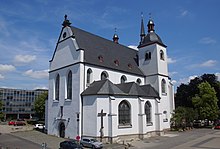Deutz Abbey
The Deutz Abbey was a Benedictine monastery in Cologne-Deutz at the site of the former Roman fort Divitia . Because of its rebuilt Romanesque components, the Alt St. Heribert monastery church is one of the 13 small Romanesque churches that are looked after by the Friends of Roman Churches in Cologne .
history
The abbey was founded in 1003 by Cologne Archbishop Heribert and settled with Benedictine monks . The bishop was a close advisor to Emperor Otto III. and had promised him on his deathbed at Castel Paterno near Rome a year earlier that he would found a monastery in honor of Saint Mary .
In his deed of donation, Heribert assigned numerous benefices to the new monastery , including the parish church of Deutz with the tithe it was entitled to from the surrounding farms - Deutz, Kalk , Vingst , Poll , Rolshoven and Westhoven . In addition, a quarter of the then archbishop's royal forest and half of the Gremberg, both extensive forest areas on the right bank of the Rhine, were allocated to the monastery .
A large Romanesque abbey church as the center of the complex was inaugurated by Heribert in 1020. A year later, Heribert's remains found their final resting place here. The central building of the church at that time, which has not been preserved, was particularly significant. The wood engraving from 1530 on the right gives an impression.
At the time of Annos II or one of its immediate successors, Deutz became part of the Siegburg reform . Among the abbots counted Rupert of Deutz (1129 †), a Benedictine monk from Liege and important theologian of his time. He presided over the monastery from 1121 to 1129.
The strategic location on the Rhine made the place a scene of fighting. The complex was destroyed and rebuilt in the 14th and 16th centuries. The current construction of the former monastery church dates back to 1663. In place of the central building there was a pillar basilica with two choir flank towers. The furnishings were in the baroque style . During the time of Napoleon the monastery was secularized . In 1804 the monastery church was elevated to a parish church in Deutz because the previous church was badly damaged in the great Rhine flood in 1784.
The monastery building itself was badly damaged in World War II , so that only the ground floor and parts of the vaulted cellar remained. In the 1970s the building was rebuilt, with the facade corresponding to the historical appearance and a listed building. The building now houses a Caritas senior citizens facility . Inside are the wall paintings by contemporary artist Werner Weber.
Towards the end of the 19th century, the parish church of Neu St. Heribert was built in the center of the Deutz district . The gold-forged shrine with Heribert's bones from the 12th century is also located there today. The old monastery church is currently the place of worship for the Greek Orthodox community in Cologne.
literature
- Monica Sinderhauf: Deutz Abbey and its inner renewal. Monastery history as reflected in the lost Codex Thioderici . Publications of the Cologne History Association e. V., Vierow 1996.
Web links
- Illustration by Frans Hogenberg from 1588: Devtsch. From Beyern Hertzog Ernst addressed, An Truchses instead of the Bischoff kandt, Zu Teutsch occupied the abbey, ... ( digitized )
- Digitized archive holdings on Deutz Abbey in the digital historical archive in Cologne
- Romanesque churches in Cologne: Alt St. Heribert in Deutz. In: Web presence Förderverein Romanische Kirchen Köln . Retrieved July 5, 2019 .
Coordinates: 50 ° 56 ′ 17 ″ N , 6 ° 58 ′ 11 ″ E



